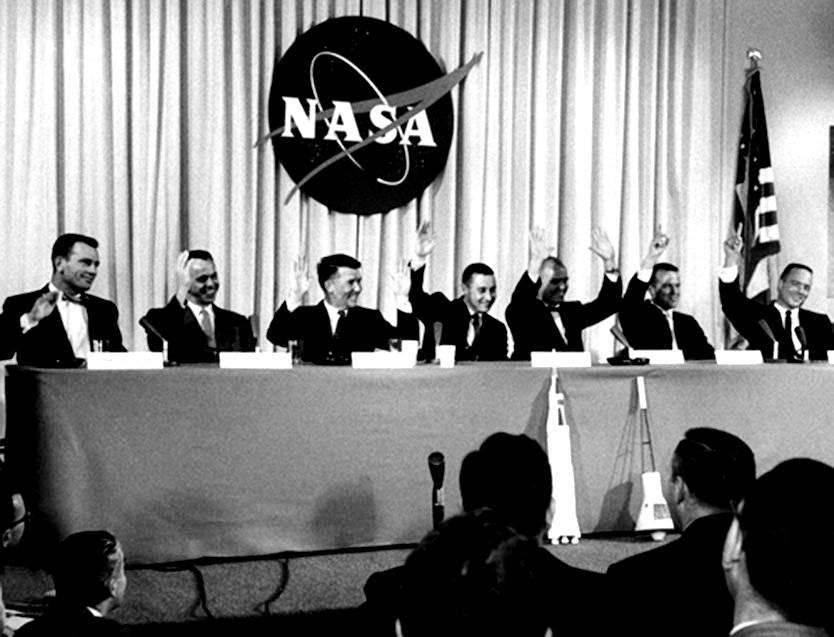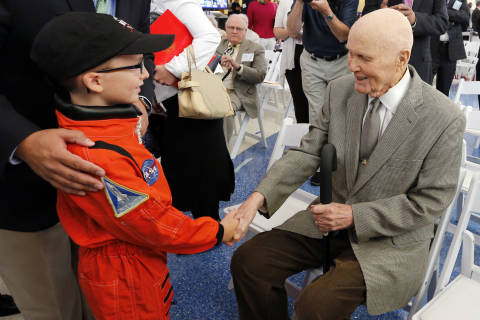John Glenn — Marine colonel, distinguished naval aviator, Mercury 7 and Space Shuttle astronaut, and U.S. senator — was a true American hero and one of the finest people to ever walk and orbit the Earth. He now belongs to the ages with his passing Thursday at age 95.
With his death, an era comes to an earthly end. During this era, NASA, in its nascent role, chose seven military men, who were proven warriors and pilots, to be America’s Mercury 7 astronauts. These seven would go up against cosmonauts from the USSR in the declared “Space Race”: the United States and democracy against the USSR and communism in competition for the hearts and minds of the earthbound via the new high ground of space.
It was an uncertain time for humanity. During the Cold War era, the U.S. and USSR had its doctrine of “mutually assured destruction.” With thousands of nuclear weapons in fleets of bombers and eventually, thanks to the Space Race, atop intercontinental ballistic missiles, possibilities of complete destruction for the enemy’s civilian population and industrial capability through the horror of all-out nuclear war seemed to lurk in the background constantly. And in October 1962, the world held its breath for 13 days as the threat of nuclear war loomed with the Cuban missile crisis.
Presidents Eisenhower and Kennedy guided American efforts to match the Soviets in space, but America was falling behind. The Soviets, with their captured Nazi German rocket scientists from World War II who developed the V-1 and V-2, coupled with their secretive space program, startled the world on Oct. 4, 1957 with the orbiting satellite Sputnik. Every 90 minutes, the beeping spacecraft could be seen flying overhead, telling the world that it — and the Soviets who put it there — were in command of space. For American military and political leaders, it was catastrophic — next the Soviets could be putting nuclear bombs in space.
American attempts to launch a satellite ended in spectacular explosions seen by the world through live broadcasts. But the country finally got a diminutive satellite, Explorer 1, into orbit on Jan. 31, 1958.
It was only a matter of time until either side would attempt to put a man in orbit. NASA launched a recruiting effort in January 1959 to obtain the best fighter/test pilots in the U.S. military to become astronauts. After arduous medical, physical and psychological testing, the Mercury 7 were introduced to the world in an April 9, 1959 news conference held in Washington, D.C.
John Glenn was the only Marine astronaut, wore a bow tie and became famous in an iconic photo for raising both of his hands when a reporter asked him and his colleagues which of them wanted to be first in space. Most of his fellow astronauts only raised one hand.

The USSR shocked the world again when cosmonaut Yuri Gagarin successfully orbited the Earth on April 12, 1961 in Vostok 1. NASA responded a few weeks later with the suborbital flight of Alan Shepard, the first American and naval aviator to go into space on May 5, 1961. Gus Grissom followed with a second suborbital flight in which his spacecraft was lost at sea.
NASA decided to move on to a flight using the Atlas missile, the most powerful rocket in U.S. inventory but also one with a history of spectacular failures. It was not a totally reliable launch vehicle but if America wanted a man to orbit Earth, it was the only way to go. NASA wanted to fly a three-orbit mission as soon as possible to eclipse the success of Gagarin’s flight.
On Aug. 7, 1961, the Soviets triumphed again with the amazing feat of Gherman Titov, whose Vostok 2 spacecraft orbited the Earth for a full day and 17 ½ orbits. This was unprecedented and totally beyond the capability of the U.S. to respond in kind, but it had to respond with getting an American into orbit as quickly as possible.
NASA finally responded on Feb. 20, 1962 with the launch of John Glenn in Friendship 7 atop an Atlas rocket. He orbited Earth three times and was in space a little over four hours. His spacecraft suffered a technical malfunction that required him to take manual control to fly Friendship 7 and there was an indicator light that a heat shield clamp had released. This meant that the attached retropack, which fired to slow the spacecraft and bring it back to Earth, would remain attached to the heat shield — something that had never been done before. It was a very distinct possibility that the heat shield could come loose and fail, literally frying Glenn.
The heat shield held; it was determined post-flight that the indicator light was a false reading, but the tension and apprehension for Glenn’s safe return was not.
He returned to a well-deserved hero’s welcome and became close to President Kennedy, who told NASA he did not want Glenn flying in space again for fear he may be killed. Glenn left NASA and the Marines and went into business and politics, becoming a long-term U.S. senator from Ohio.
Glenn flew in space again at 77 years old — the oldest person to date — aboard Space Shuttle Discovery in 1998 for nine days. He provided valuable medical knowledge about aging in space and wasn’t one bit worse for wear upon return to Earth — something critics had predicted.
I watched the Mercury missions enthralled, but while still quite young. It was the Gemini program followed by Apollo that I truly immersed myself in while growing up.
We soundly defeated the Soviets in the long run of the Space Race. Now, American astronauts and Russian cosmonauts fly together aboard the International Space Station. I hope this international cooperation continues.
Glenn was the last of his fellow Mercury astronauts to walk among us. They leave a legacy of history and accomplishments that can never be repeated — the first American astronauts — in a time that will never be again. I will always remember them in their group poses: in fighter pilot attire near a sleek F-106 fighter, dirty, unshaven and in long johns during survival school, and the iconic silver spacesuit portrait.
Godspeed, Mercury 7. You now belong to the stars.
Follow my daily blog to keep up with the latest news in astronomy and space exploration. You can email me at skyguyinva@gmail.com.





